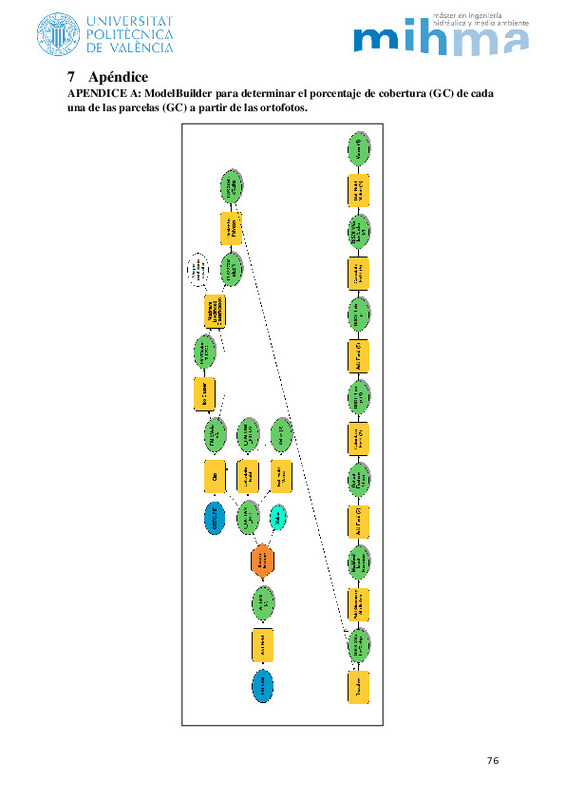|
Resumen:
|
[ES] La agricultura representa alrededor del 70% de las extracciones de agua dulce en el mundo, y generalmente se considera como el factor principal detrás de la creciente escasez mundial de agua; y los escenarios de cambio ...[+]
[ES] La agricultura representa alrededor del 70% de las extracciones de agua dulce en el mundo, y generalmente se considera como el factor principal detrás de la creciente escasez mundial de agua; y los escenarios de cambio climático prevén que esta aumente. Y dado que, en la actualidad, el 19.7% de las tierras cultivadas está bajo riego. Es esencial el desarrollo de herramientas avanzadas y precisas que permitan clasificar y monitorear los cultivos. Una de estas herramientas es la teledetección; ya que facilita la gestión del riego y el uso óptimo durante el ciclo del cultivo.
Por este motivo el desarrollo del siguiente trabajo tuvo como objetivo evaluar la utilidad de las imágenes del satélite Sentinel-2 en la gestión del regadío, particularmente en cultivos leñosos de hojas perennes y caducifolias; específicamente para los cítricos y caqui.
Para ello la extracción de la información de las imágenes Sentinel- 2 se hizo a partir de parcelas ubicadas en el sector XI de la Comunidad de Regantes de ¿Picassent¿ mediante el uso de los sistemas de información geográfico. A partir de esa información la metodología se dividió en tres partes. La primera de ella consistió en el análisis temporal de las bandas del espectro electromagnético para cada uno de los cultivos, que permitió identificar la bandas que presentan mayor diferenciación; para luego deducir un índice de vegetación que mejor exprese la diferenciación entre los cultivos.
La segunda parte de la metodología consistió en aplicar un proceso de clasificación supervisada sobre la imagen del análisis de componentes de las banda del visible y los índices obtenidos, tomando en cuenta los meses de mayor diferenciación. Además, se estimó la exactitud de la clasificación a partir de matrices confusión.
Luego se elaboró un modelo de regresión lineal simple que estima el porcentaje de cobertura vegetal (GC) en función del NDVI. Estimado el GC se aplicó el método propuesto por Castel, (2000) para determinar el coeficiente del cultivo (Kc) en función del GC.
Y por último, se determinaron las necesidades del riego bajo la metodología propuesta por la FAO-56, y se evaluó la calidad del riego de las distintas parcelas aplicando el Índice de Calidad del Riego (SIPI).
Los resultados más relevantes de este trabajo son: La alta fiabilidad de clasificación del 94% y 91% de la imagen obtenida del análisis de componentes principales. La ecuación lineal de predicción del GC a partir del NDVI para los cultivos de cítricos cuyos valores de R2=0,8223 indican la bondad del ajuste del modelo. Por último, los mapas temáticos que muestran las necesidades de riego y el SIPI a escala parcela.
Estos resultados refuerzan el uso de la teledetección y de las imágenes del satélite Sentinel-2 como una herramienta muy útil para la gestión y seguimiento de los cultivos, en este caso leñosos.
[-]
[EN] Agriculture represents around 70% of the freshwater withdrawals in the world, and generally, it is considered the main factor behind the growing global water shortage; and the climate change scenarios foresee that it ...[+]
[EN] Agriculture represents around 70% of the freshwater withdrawals in the world, and generally, it is considered the main factor behind the growing global water shortage; and the climate change scenarios foresee that it will increase. Actually, 19.7% of cultivated land is under irrigation. It is essential the development of advanced and accurate tools that can classify and monitor crops. One of these tools is remote sensing; since it facilitates irrigation management and optimal use during the crop cycle.
For this reason, the development of the following work was aimed at evaluating the usefulness of Sentinel-2 satellite images in irrigation management particularly in ligneous crops of evergreen and deciduous leaves; specifically for citrus and persimmon.
For this, the extraction of information from the Sentinel-2 images was made from plots located in sector XI of the "Picassent" Irrigation Community through the use of geographic information systems. From this information, the methodology was divided into three parts. The first of them was the temporal analysis of the electromagnetic spectrum bands for each of the crops, which allowed to identify the bands that present greater differentiation; so then deduce a vegetation index that best expresses the differentiation between crops.
The second part of the methodology was to apply a supervised classification process on the image of the analysis of visible band components and the indices obtained, taking into account the months of greatest differentiation. In addition, the accuracy of the classification was estimated from confusion matrices.
Then, a simple linear regression model was developed that estimates the percentage of vegetation cover (GC) as a function of NDVI. With the GC estimated, the method proposed by Castel, (2000) was applied to determine the crop coefficient (Kc) as a function of GC.
And finally, crop water requirements were determined under the methodology proposed by FAO-56, and the irrigation quality of the different plots was evaluated by applying the Irrigation Quality Index (SIPI).
The most relevant results of this work are: The high classification reliability of 94% and 91% of the image obtained from the analysis of main components. The linear prediction equation of GC from NDVI for citrus crops whose values of R2 = 0.8223 indicate the goodness of fit of the model. Finally, the thematic maps that show the needs of irrigation and the SIPI at scale plot.
These results reinforce the use of remote sensor and images from the Sentinel-2 satellite as a very useful tool for the management and monitoring of crops, in this case woody.
[-]
|








